1lumen selects and reviews products personally. We may earn affiliate commissions through our links, which help support our testing.
Fenix PD36R Pro review
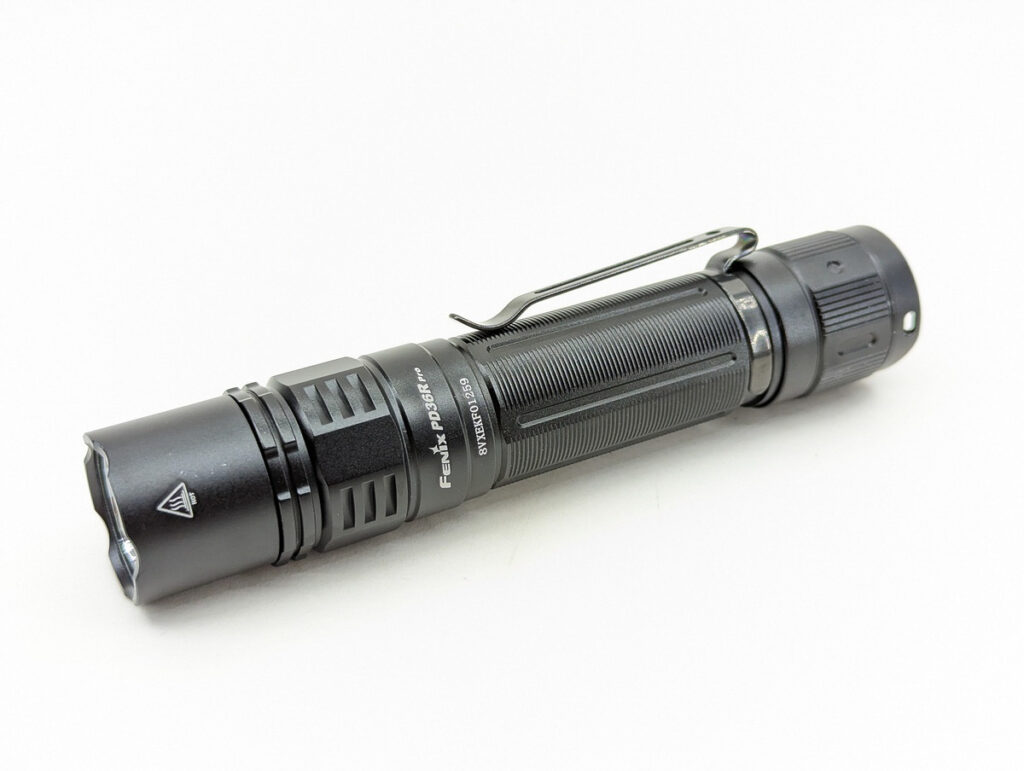
Fenix PD36R Pro specifications
| Brand & Model | Fenix PD36R Pro |
|---|---|
| Flashlight category | Tactical |
| LED | Luminus SFT70 |
| Max. output | 2800 lumens |
| Max. beam distance | 380 meters |
| Max. beam intensity | 36,600 cd |
| Battery config. | 1*21700 |
| Onboard charging | USB-C / Proprietary / Battery has a USB-C port / N/A |
| Modes | 5 |
| Blinkies | Strobe |
| Waterproof | IP68 |
| Review publication date | November 2022 |
Introduction:
Fenix makes a huge array of lights. In fact, they have an actual PDF catalog on their website (I imagine it’s probably also distributed in paper form as well) that is 48 pages long and chock-full of products ranging from tiny EDC lights all the way up to a couple really big boys that I’ve been fortunate enough to check out: the LR50R 12,000 lumen monstrosity and the HT30R 1500m throw LEP. If you need a light, chances are that Fenix will have a nice offering to fill that need.
By and large, I really like Fenix – my first “real” flashlight was a Fenix (the 187 lumen E25 model, if you’re curious). From my experience, Fenix lights are really well designed, they use quality materials and finishes, have great constant-current drivers, and publish truthful ANSI specs. I recently reviewed the small E18R V2.0 EDC light and the small-midsize PD25R. This new flashlight is the PD36R Pro. As the naming would imply, it shares a lot of features with the smaller PD25R, but of course with its predecessor, the PD36R. So what extra features does the “Pro” model bring to the table? As you’d expect: more lumens and more throw. But also a transition to dual tail switches and support for a remote pressure switch. Sounds like a worthy upgrade!
Package quality.
The packaging for the Fenix PD36R Pro is instantly recognizable as having come off the same line as the other Fenix models that I recently reviewed. They used the exact same design language and materials: a showy black and orange carton with a heavy-duty plastic tray inside. I think it’s great that Fenix is using consistent packaging as it helps drive brand recognition. Arranged in the tray was:
- Fenix PD36R Pro
- Battery
- Charging cable
- Spare o-ring
- Holster
- Pocket clip (pre-installed)
- Lanyard
- Manual and other literature
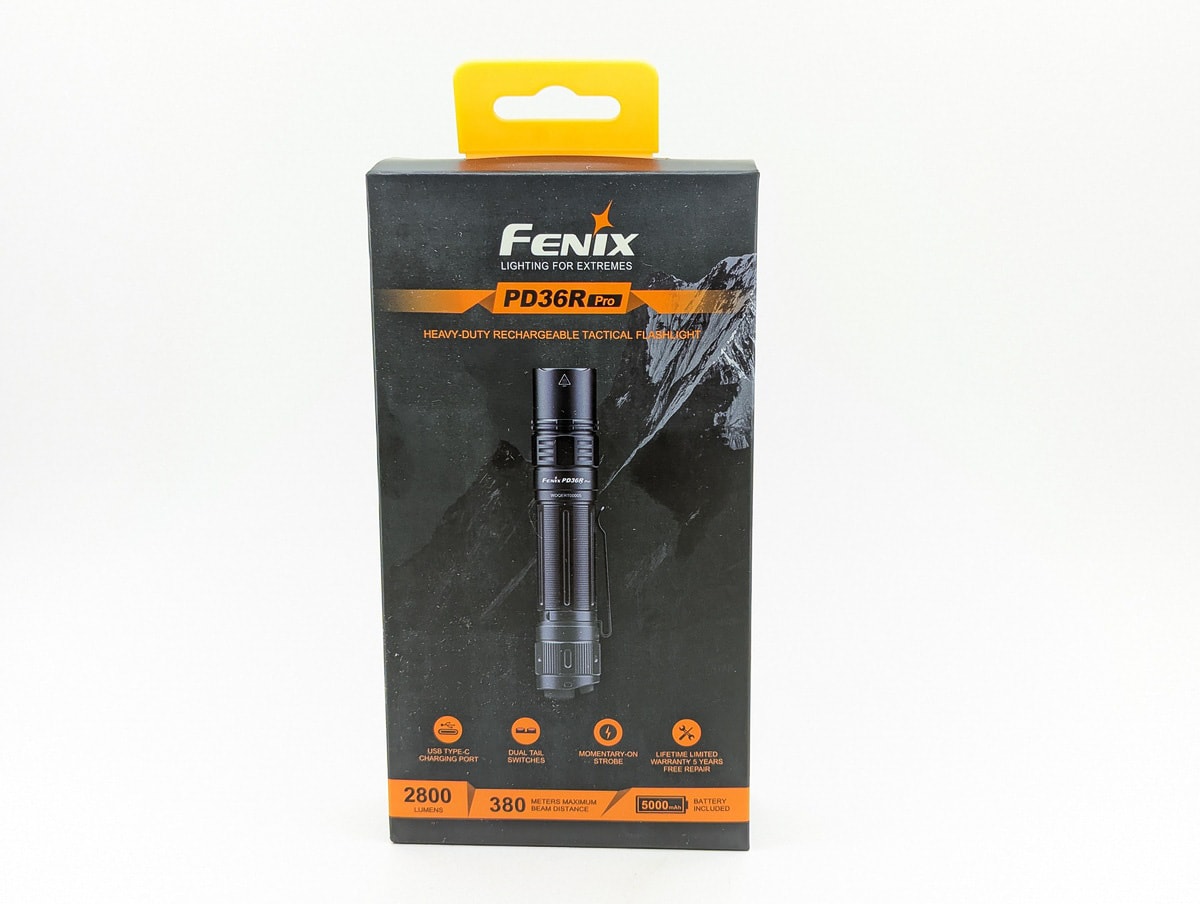

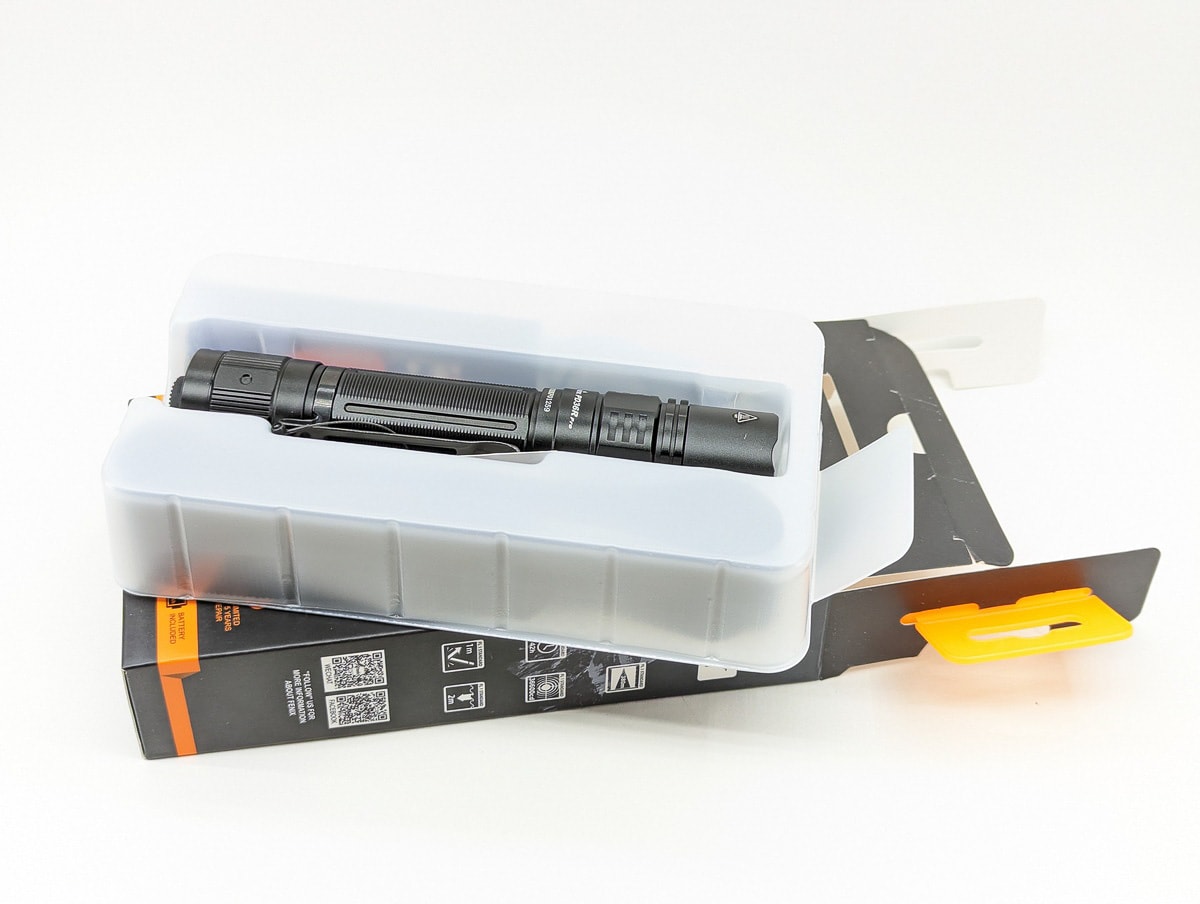
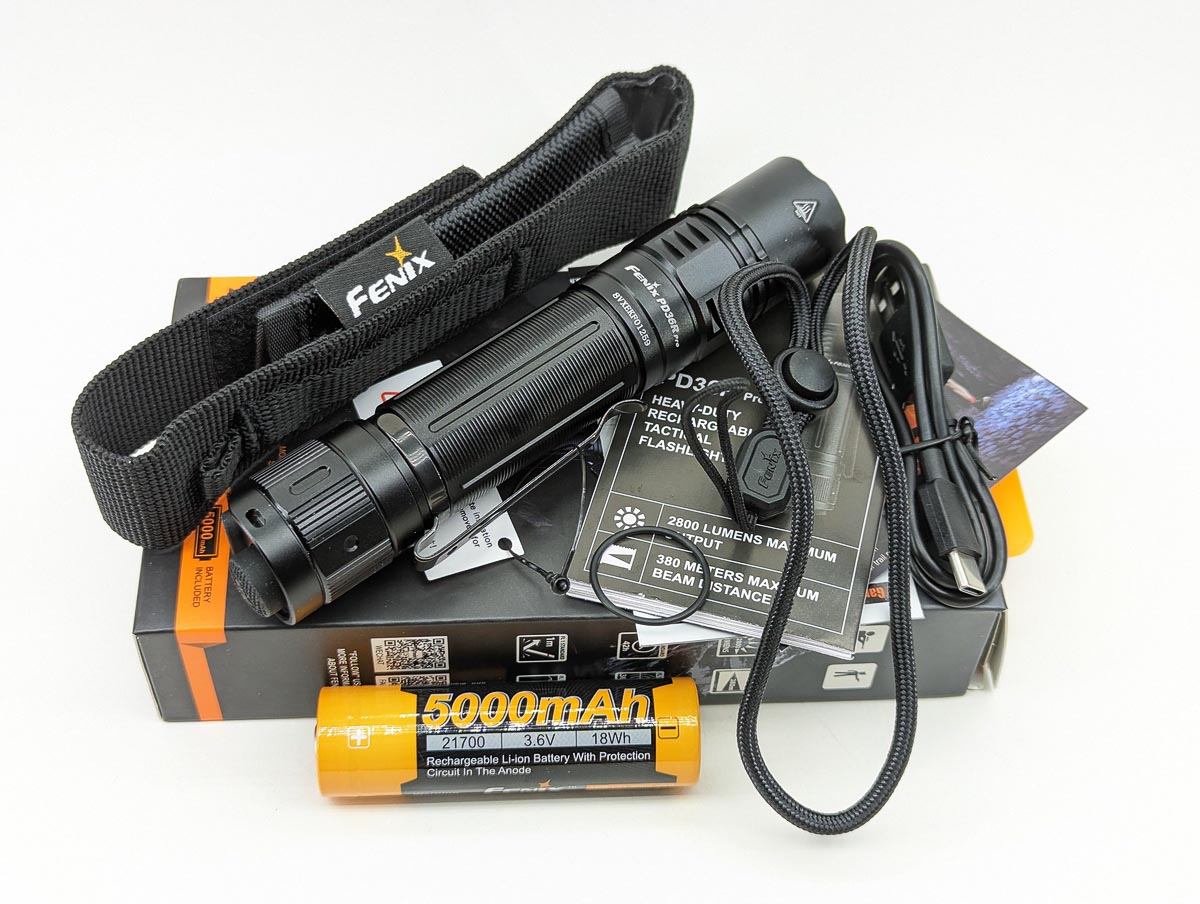
Flashlight in use
Size-wise, I consider the PD36R Pro to be very comfortable to hold and operate. I feel like 21700 lights strike a nice, happy medium on sizes and overall sit in the hand pretty well even if they tend to be too big for EDC carry. In terms of carry, the Fenix PD36R Pro comes with a pocket clip preinstalled. The clip is very firmly attached and should work well, though I can’t see pocket-carrying the PD36R Pro too often – it’s on the large side of lights that I would stow away in my pocket unless I really knew I was going to need it. Fenix included a lanyard that is a small step above your average flashlight lanyard – it is embossed with the Fenix logo and it has an adjustable bead for cinching the lanyard down. Lastly, Fenix also threw in a fabric holster for this light. The holster seems to work well and would probably be my preferred carry method if I wanted the PD36R Pro with me frequently.
The Fenix PD36R Pro has two switches, and both of them are on the tailcap. The main switch is a clicky on-off switch that also provides momentary activation. The second, less pronounced, button is an e-switch that is used for instant-Strobe and switching modes. Due to tail switches protruding from the end of the light, this light does not tail-stand.
First and foremost, I see the PD36R Pro as a tactical/duty light. With the dual switch tail design, access to instant strobe, momentary functionality, and compatibility with remote switches (sold separately), I think that’s a great use for this light. But you could just as easily use it hunting, hiking, or when something goes bump in the night.
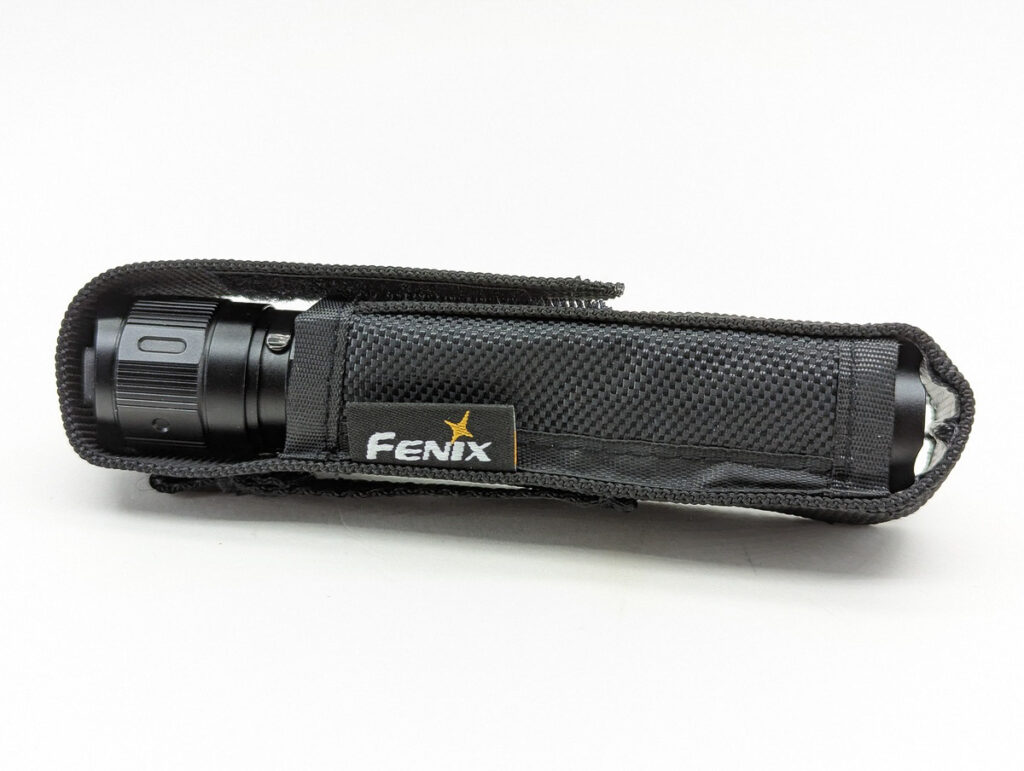
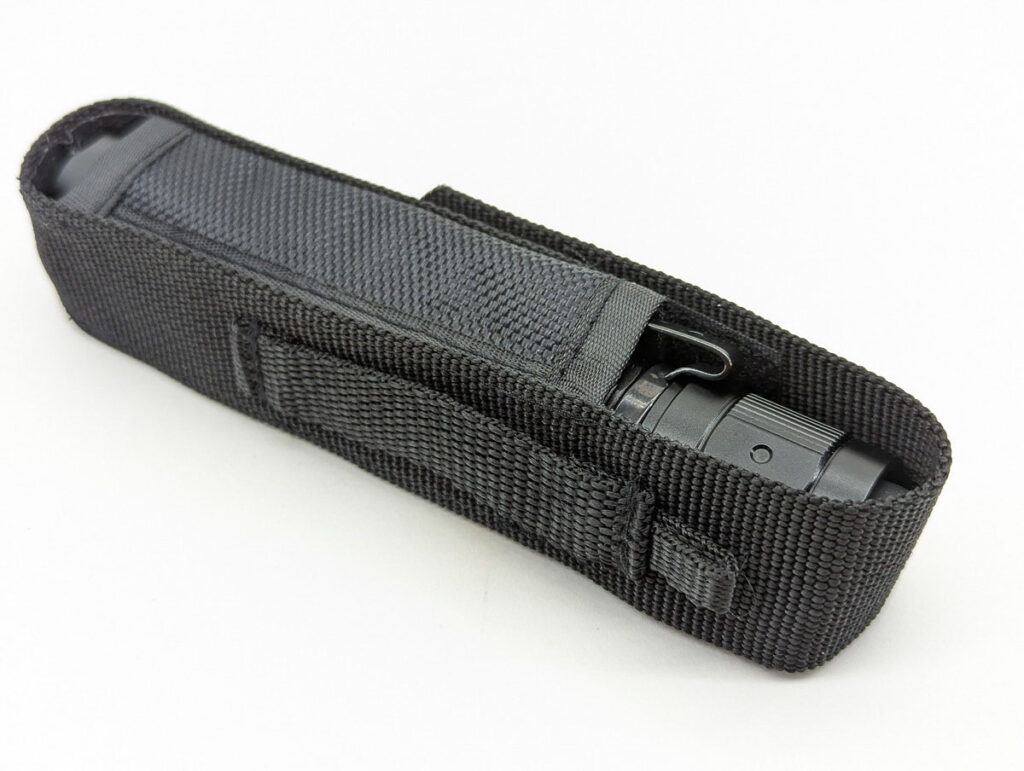
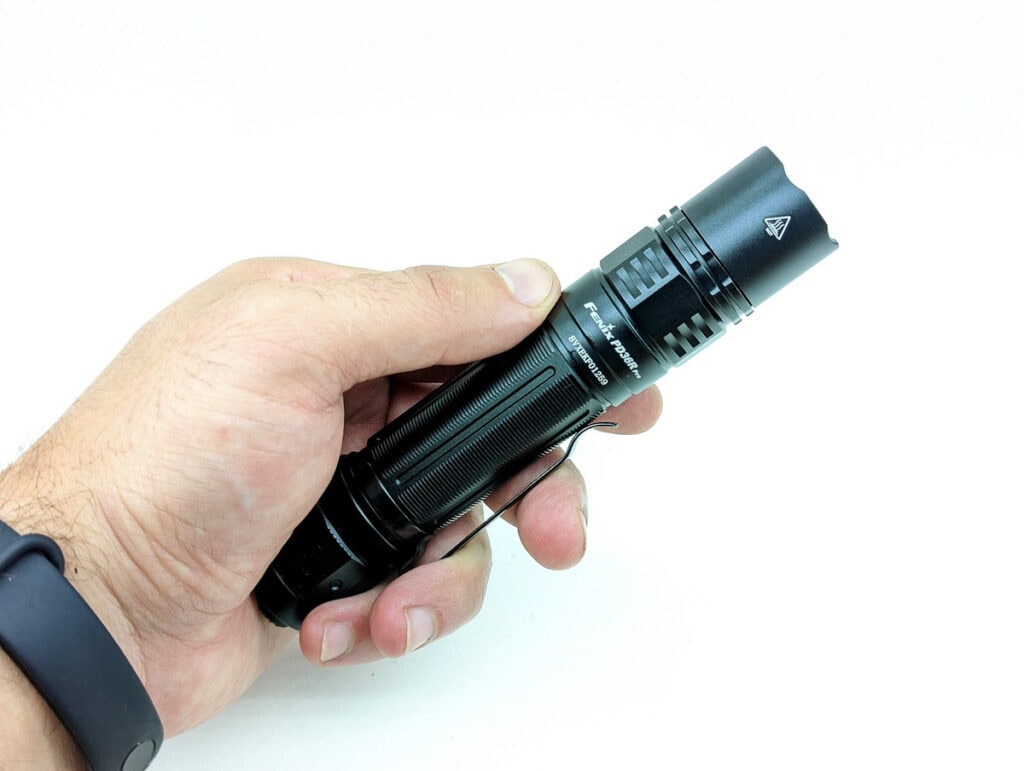
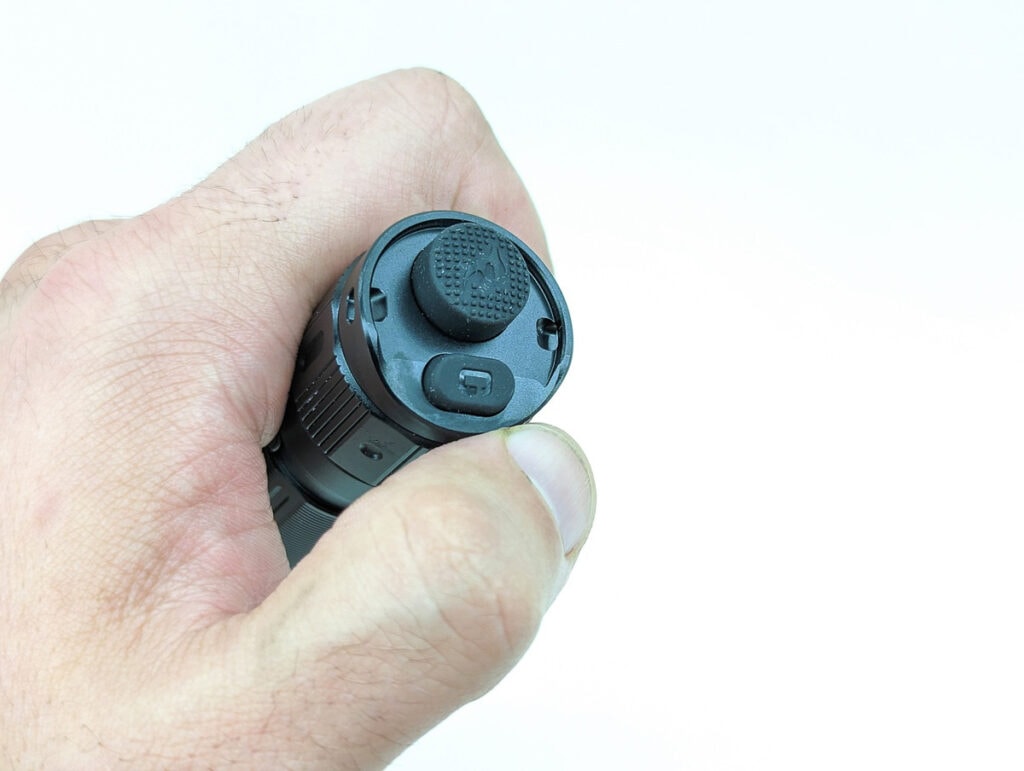
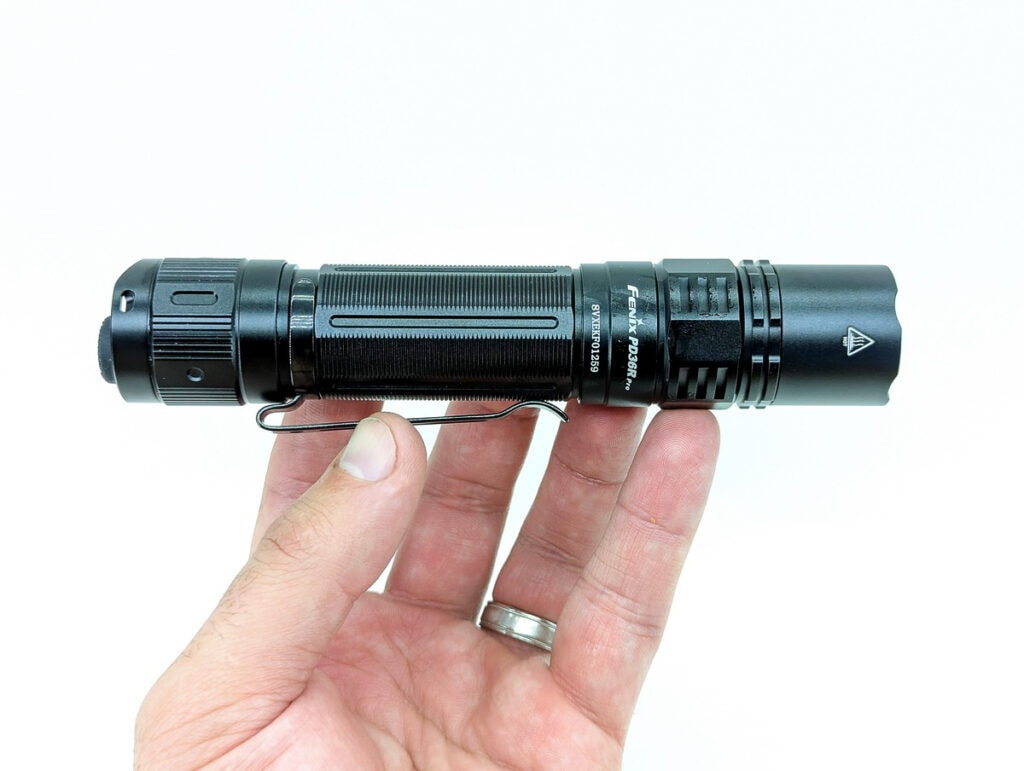
Build Quality, and Warranty
Fenix used A6061-T6 aluminum in the construction of the PD36R Pro, then coated it in premium type III hard anodizing. The fit and finish look absolutely great, as I’ve come to expect from Fenix.
There’s no knurling to speak of. There are tiny grooves machined into the battery tube but they don’t provide much grip. Likewise, there are some light grooves in the tailcap that assist slightly when removing and installing the tailcap.
Warranty:
- 15 days from date of purchase: replacement from Fenix for manufacturing defects
- 5 year from date of purchase: free repairs
- Lifetime maintenance, with customer covering the cost of parts
- Extra 6 month warranty period for products registered on Fenix’s website
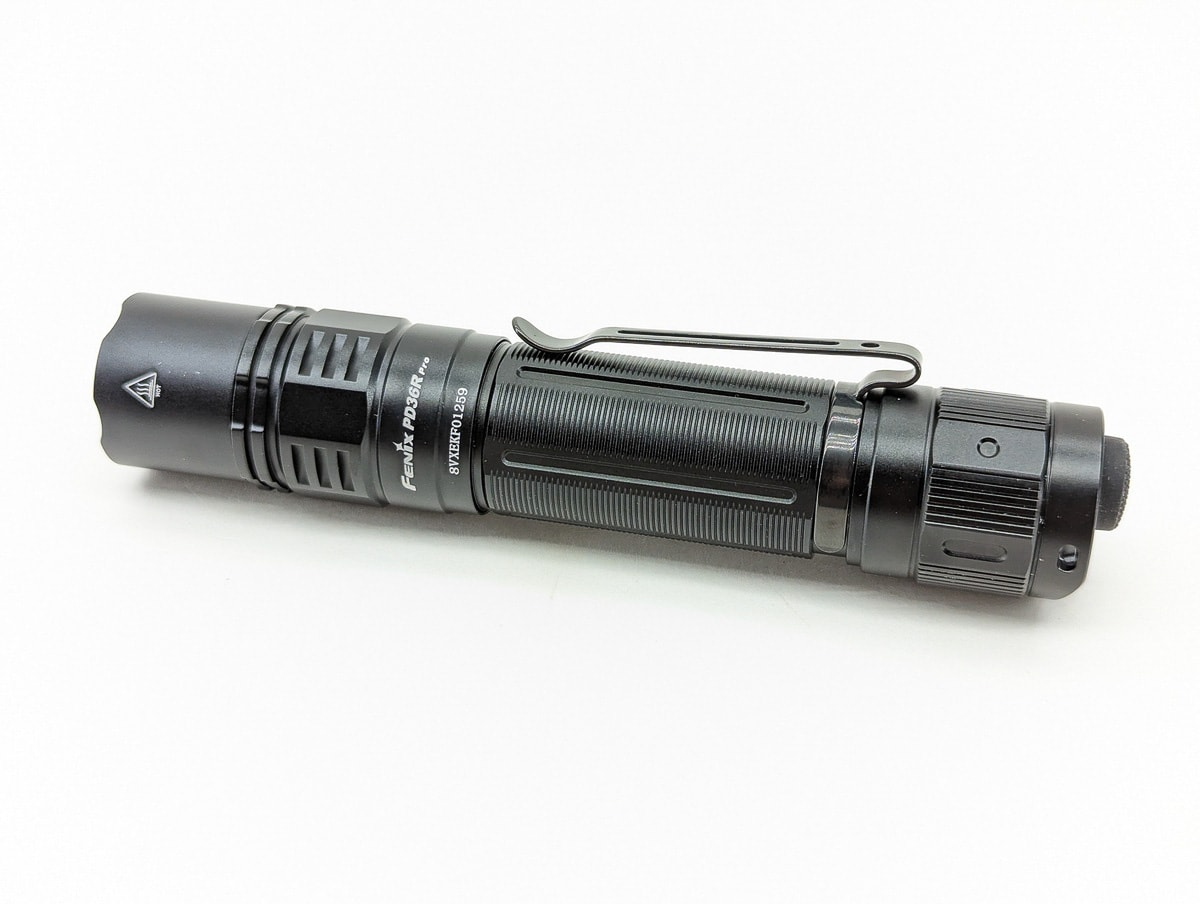
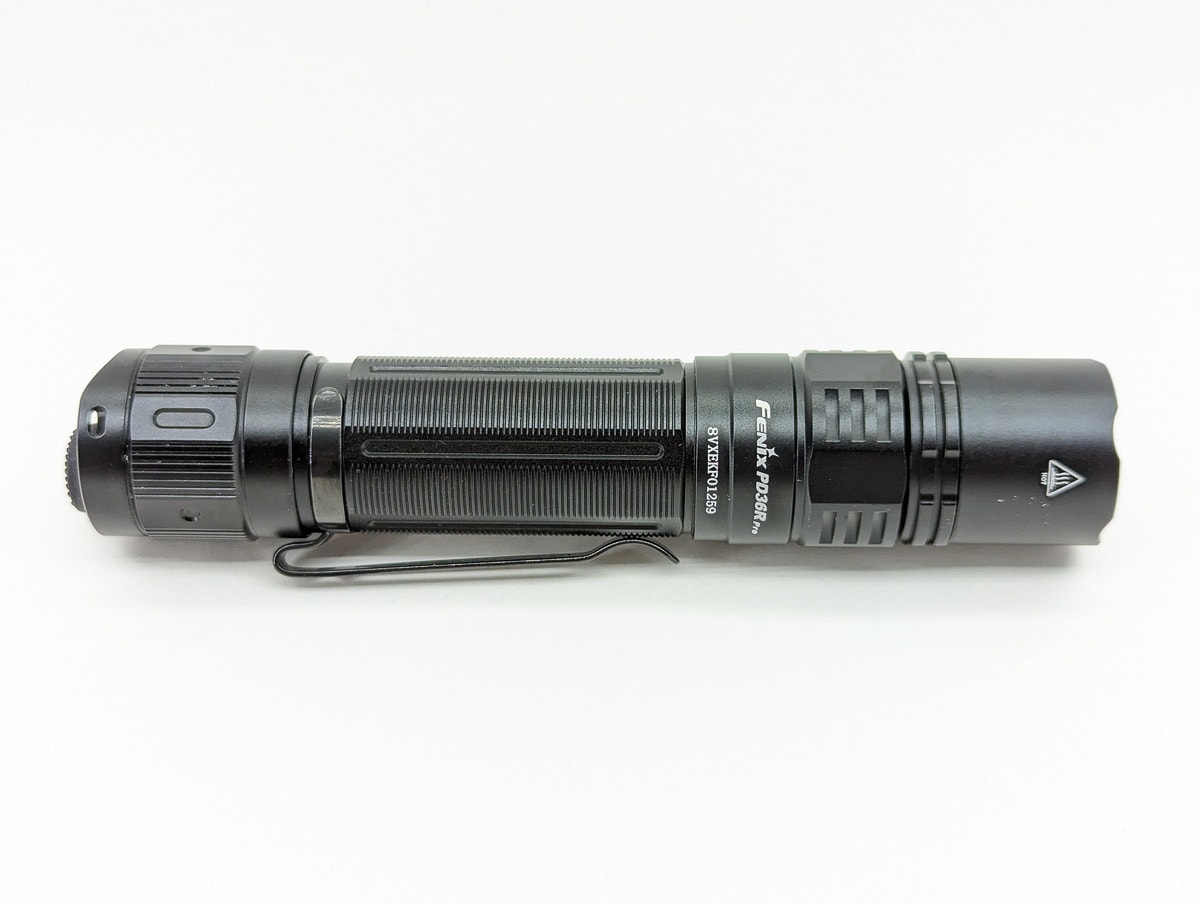
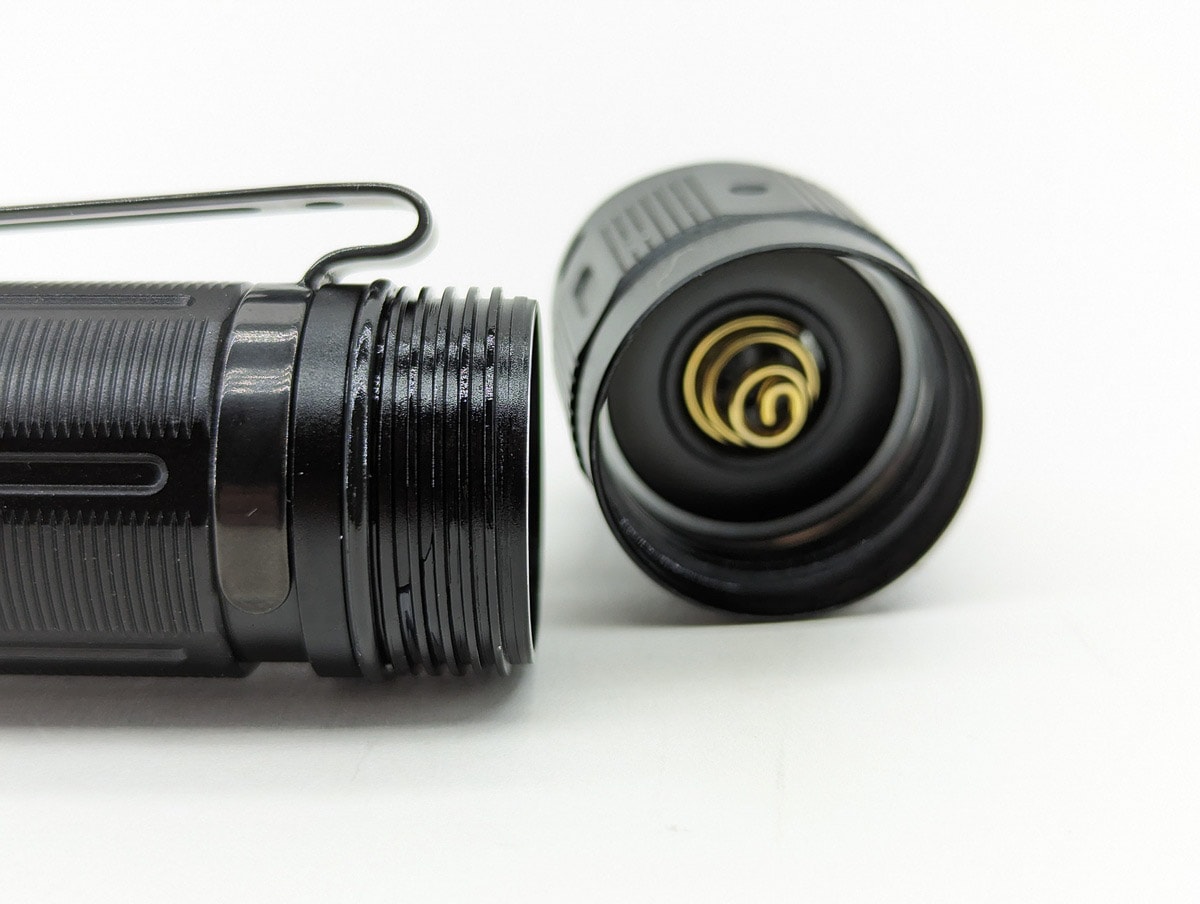
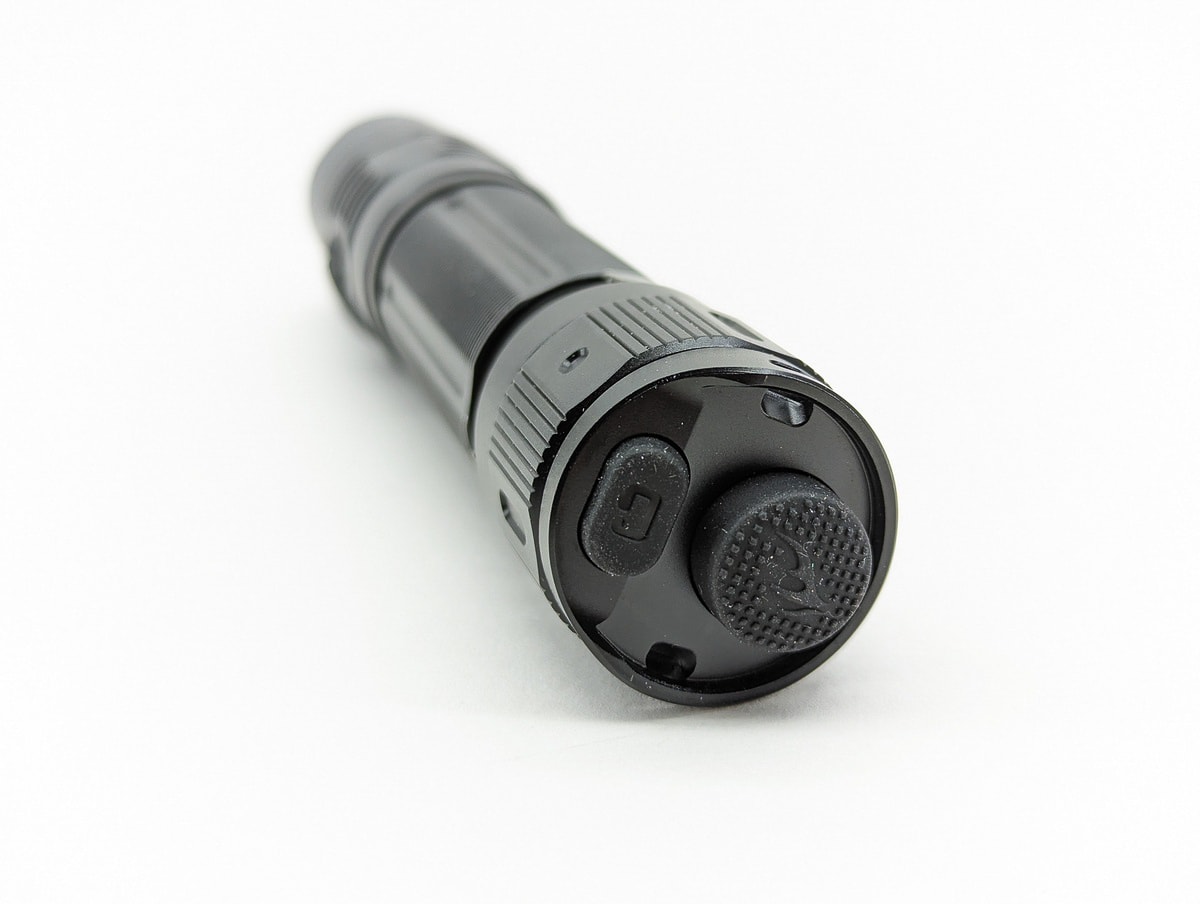
LED, Lens, Bezel, Beam, and Reflector
Fenix went with a Luminus SFT70 LED for the PD36R Pro. This isn’t an LED that I’ve seen much of. It’s a lot like the SFT40 – it retains the same 5050 footprint and a similar physical appearance, but it’s a quad-die LED and runs at 6V or 12V. According to Luminus, the LED is capable of producing over 3500 lumens. Being a domeless LED, it throws very well. It is 70 CRI LED. The LED is nicely centered in a medium-sized, smooth reflector. The reflector produces a clearly defined hotspot and moderate spill.
I got the following measurements of the center of the beam with my Opple Light Master at 3 meters with the Fenix being on Turbo:
- CCT: 6526K
- CRI: 71.0 Ra
- DUV: +0.0011
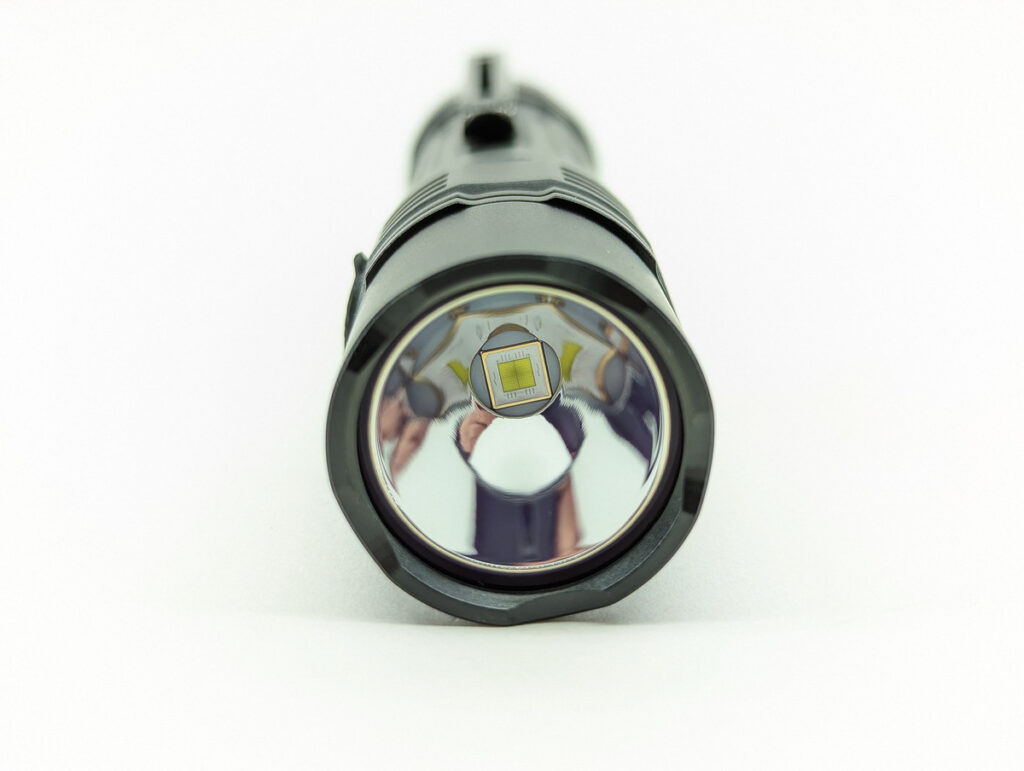
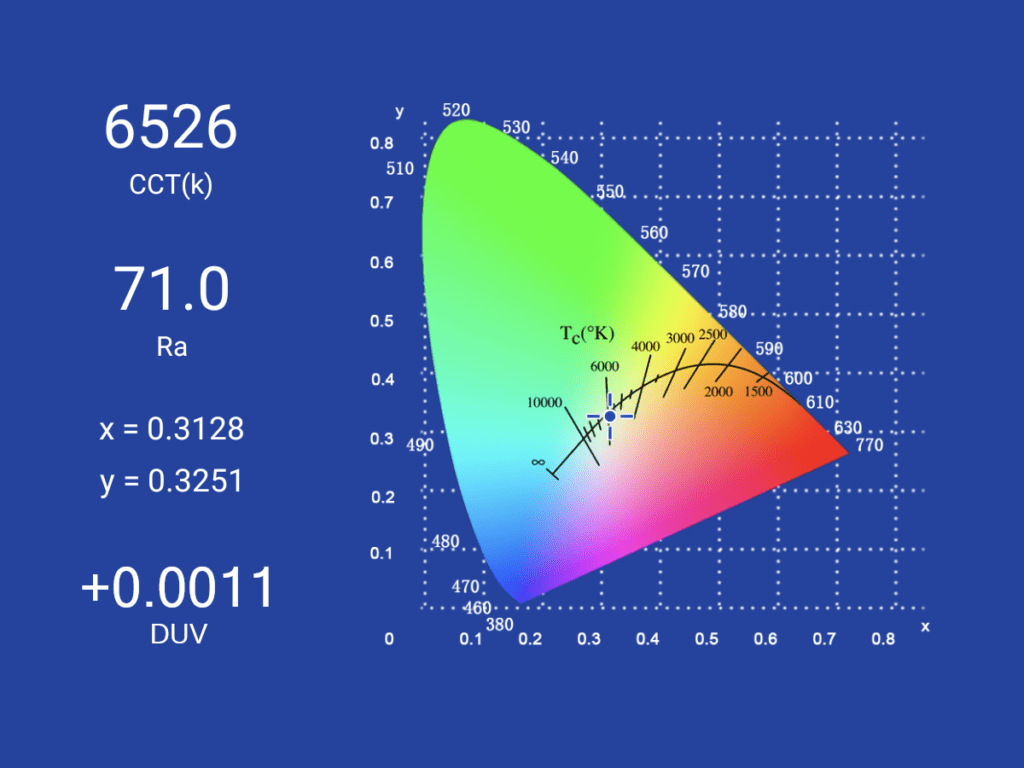
Dimensions and size comparison
Dimensions:
| Dimension | Millimeters | Inches |
|---|---|---|
| Length | 146 mm | 5.7 |
| Head diameter | 27 mm | 1.0 |
| Body diameter | 26 mm | 1.0 |
Dimensions are rounded to the nearest millimeter, and to the nearest tenth of an Inch.
Weight:
| Weight | Grams | Oz. |
|---|---|---|
| Without battery: | 99 | 3.5 |
| With battery | 171 | 6.0 |
Weight is rounded to the nearest gram, and to the nearest tenth of an Oz.
Flashlight size comparison with its competition
Group 1: Fenix E-CP, Fenix PD36R Pro
Group 2: Fenix PD25R, Fenix PD36R Pro, Fenix HT30R
Group 3: Nitecore P20iX, Fenix PD36R Pro, Wuben T1
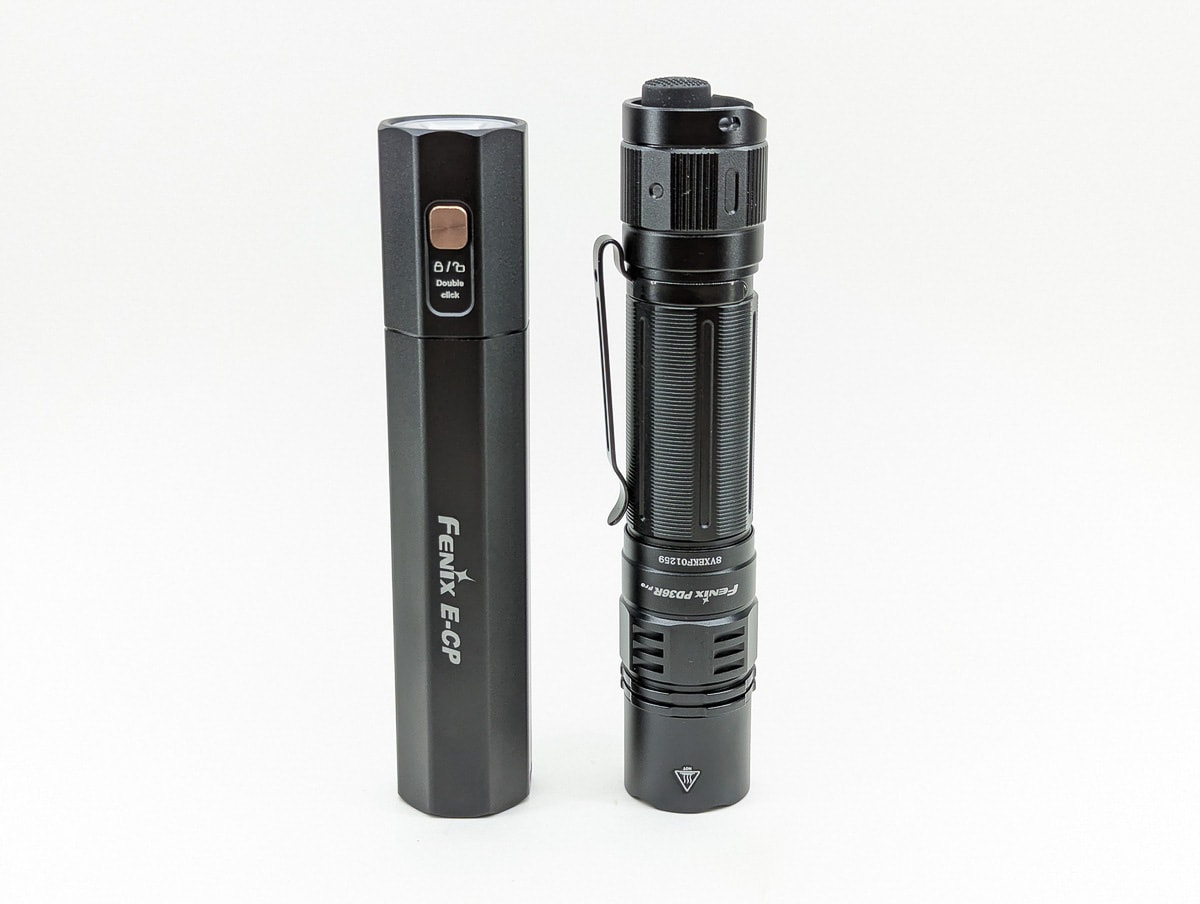
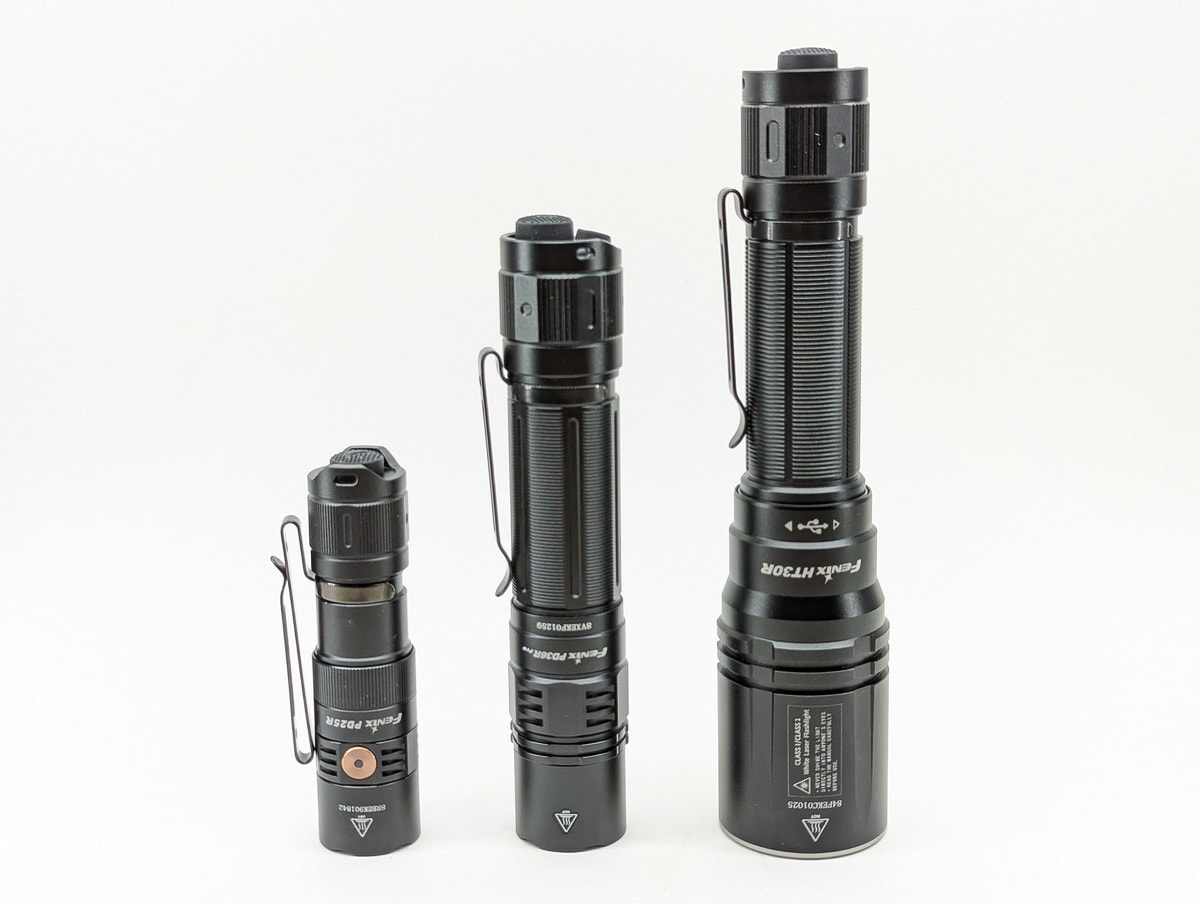

Driver & User Interface:
The UI of the Fenix PD36R Pro is relatively simple. It uses two buttons, both of which are on the tailcap. The main button, which Fenix calls the “Tactical Switch”, is a forward-clicky that is responsible for on-off. The other button, which Fenix calls the “Functional Switch”, is a smaller, less pronounced e-switch that is used for “instant strobe” and for mode switching.
Available modes: Turbo, High, Medium, Low, Eco
Available blinky modes: Strobe
User interface:
From OFF:
- Tactical Switch, half-press and hold: momentary on
- Tactical Switch, single click: turn on
- Functional Switch, press and hold: momentary strobe
From ON:
- Tactical Switch, single click: turn off
- Functional Switch, press and hold: strobe
- Functional Switch, single click: switch modes
Mode memory:
- Yes, it will remember the “normal” modes, but not Strobe
Shortcuts:
- To momentary Strobe: press and hold the Functional Switch from Off
- To constant Strobe: press and hold the Functional Switch from On
Low voltage warning:
- The light will step down in modes until it reaches Eco mode. Once it gets to Eco mode, the battery indicator LED will blink red
- When you turn the flashlight, the battery indicator LED will light up for 3 seconds to show the battery level:
- Green, constant: between 100% and 85%
- Green, flashing: between 85% and 50%
- Red, constant: between 50% and 25%
- Red, flashing: between 25% and 1%
Strobe/blinkies
- Yes, there is both a constant strobe and a momentary strobe
- From Off, press and hold the Functional Switch to enable the momentary strobe
- From On, press and hold the Functional Switch to enable constant strobe
Lock-out mode:
- There is no electronic lockout, but you can physically lock it out by twisting the tailcap
PWM
- There is no PWM
Additional info on the UI:
- There is “intelligent overheat protection” that reduces output to keep the temperature at or below 60° C
Batteries & Charging
The PD36R Pro comes with a Fenix-branded cell, the Fenix ARB-L21-5000 V2.0. It is not a proprietary battery, just a button-top 5000 mAh 21700 battery with a protection circuit. I tried a flat-top Samsung 40T battery and it was too short to make contact. Even a solder-blobbed 40T was a bit too short. You’ll need to run protected cells in the PD36R; thankfully Fenix included a nice one in the box.
The Fenix PD36R Pro has built-in USB-C charging via a port on the side of the head which is covered up by a typical rubber dust plug. Fenix says that a fully depleted battery should take 3 hours to recharge. While charging, the indicator LED will illuminate red, then switch to green when charging is complete. In my testing, I observed a 11 watt charge rate (2.2A at 5V) and the cycle completed in 2 hours 51 minutes.
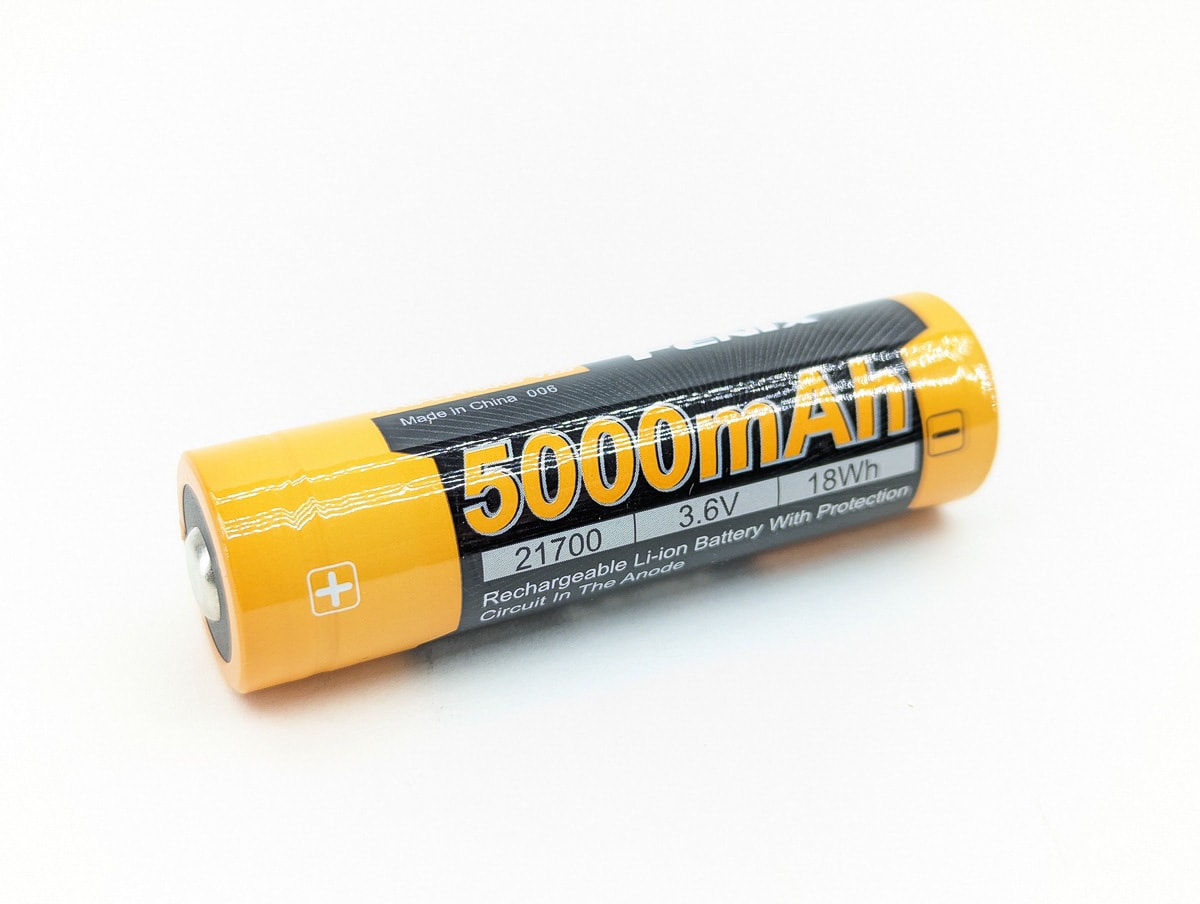
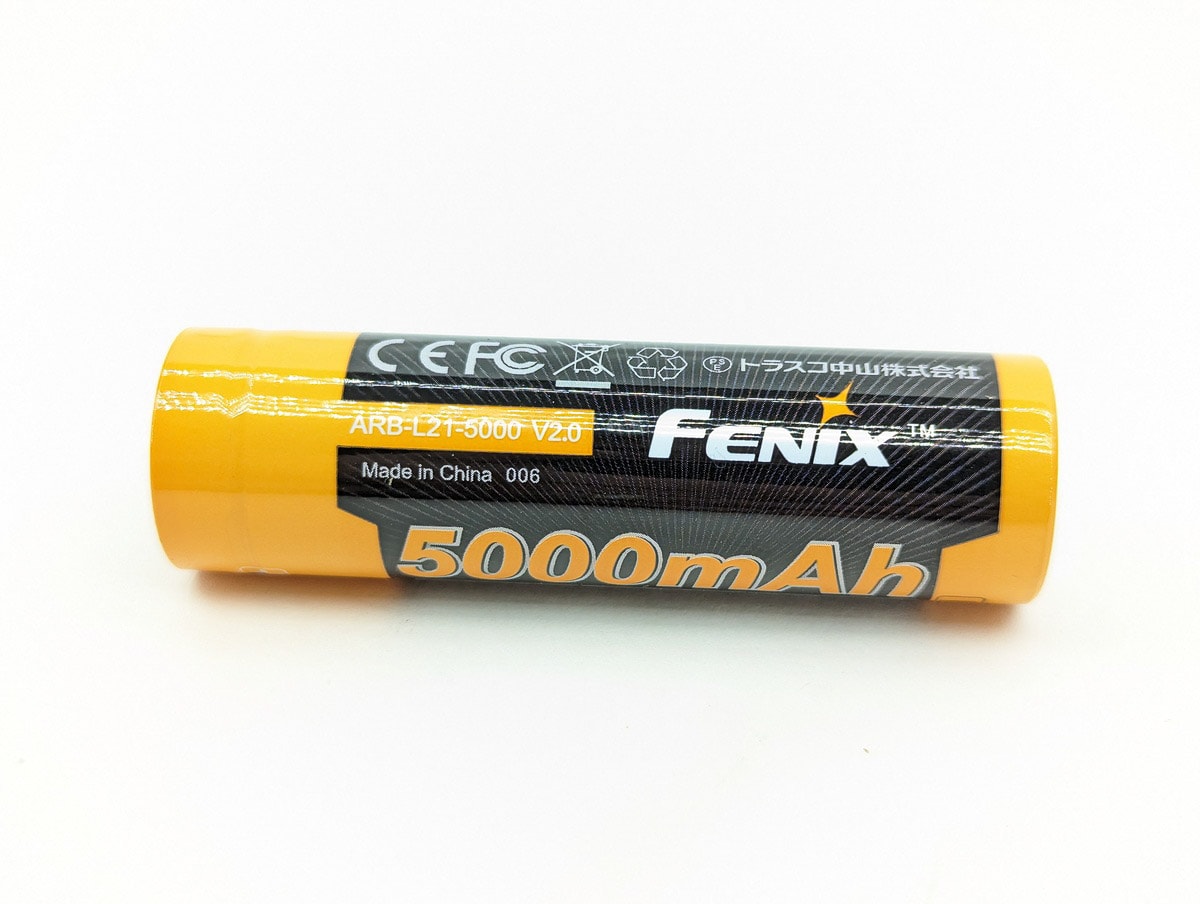
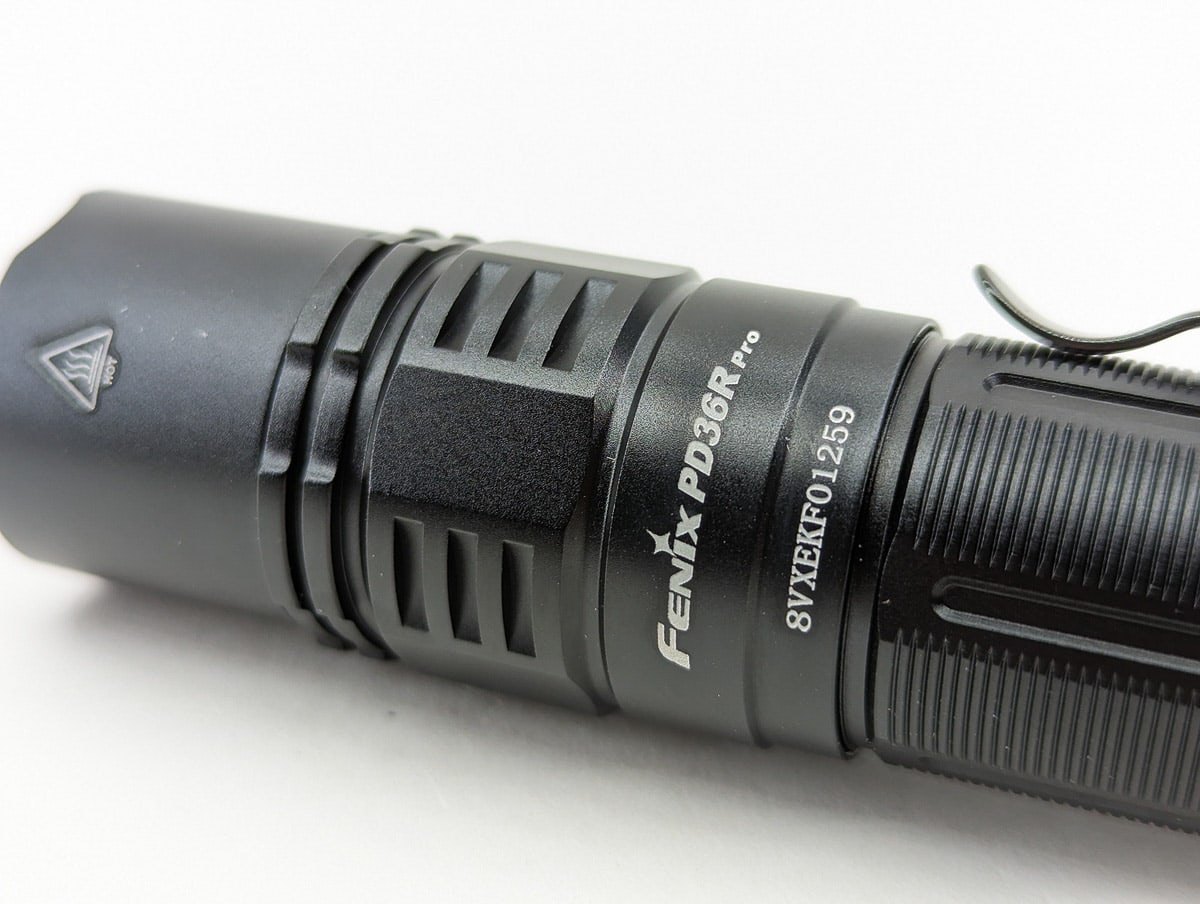

Performance test
Lux was measured by a UNI-T UT383 BT at 5 meters. Lumens were measured in a homemade lumen tube using a TSL2591 sensor, calibrated with a Maukka calibration light. The temperature was monitored with a MLX90614 IR temperature sensor. The included Fenix battery was used for testing.
Lumen measurements
| Mode | Specified | turn on | 30 sec | 10 minutes |
|---|---|---|---|---|
| Eco | 30 lm | 32 lm | 32 lm | – |
| Low | 150 lm | 130 lm | 130 lm | – |
| Medium | 350 lm | 392 lm | 390 lm | 384 lm |
| High | 1000 lm | 1104 lm | 1098 lm | 829 lm |
| Turbo | 2800 lm | 3119 lm | 2494 lm | 832 lm |
| Turbo at 3.7V | – | 2884 lm | 2257 lm | – |
Parasitic drain:
- could not measure due to flashlight design
Battery Life: Runtime graphs
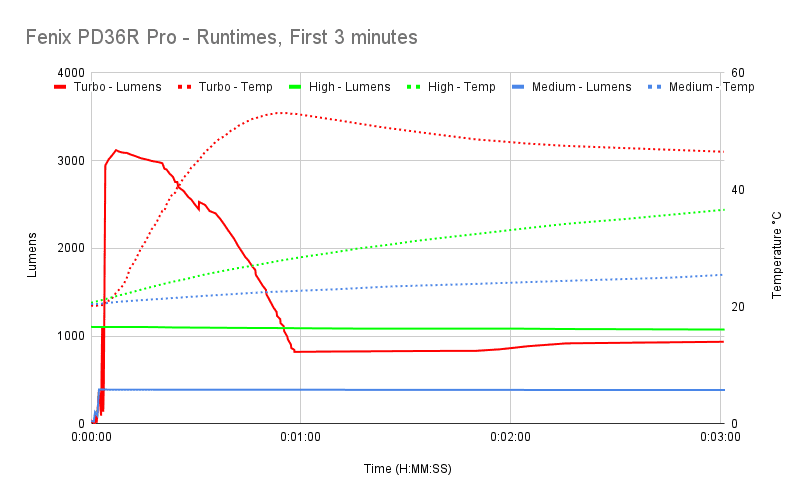
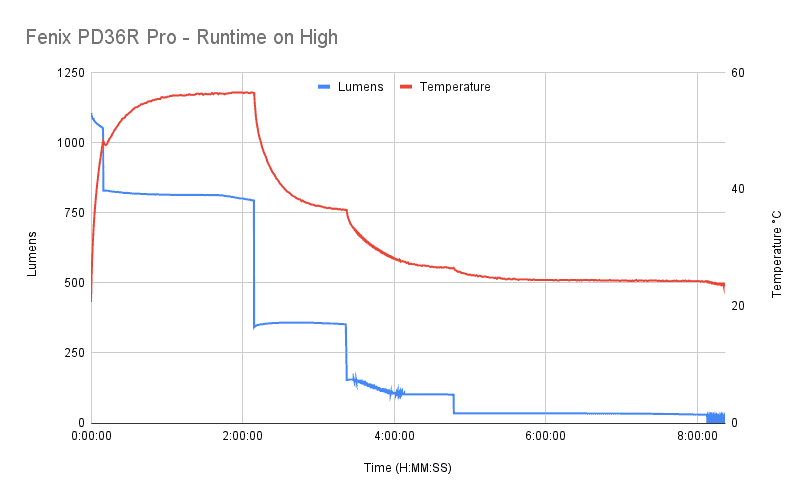
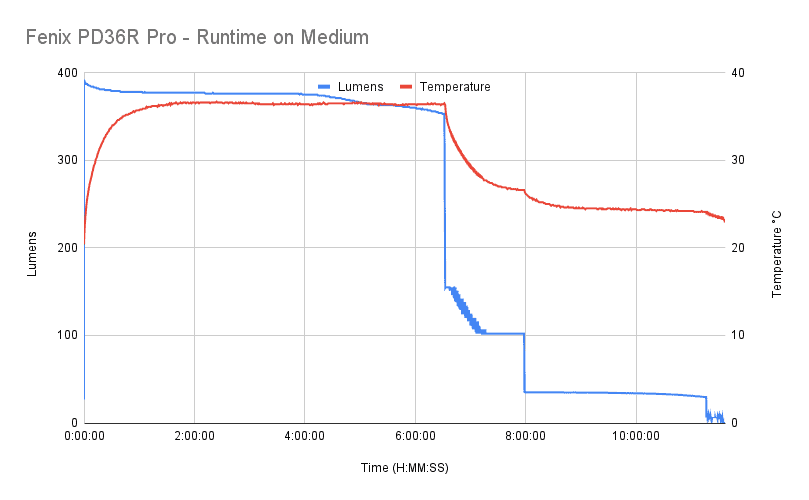

| Mode | Specified | Measured runtime (ANSI) | Time till end of test |
|---|---|---|---|
| Eco | 42h | – | – |
| Low | 19h | – | – |
| Medium | 8h 15 min | 7h 58 min | 11h 34 min |
| High | 3h 55 min | 3h 53 min | 8h 21 min+ |
| Turbo* | 3h 30 min | 3h 21 min | 4h 22 min+ |
In the runtime tests, the output got to points where it would rapidly fluctuate a small amount (say, 5-10% of output). The difference is enough that it would trigger my lumen logger to take a reading several times per second and eventually the flood of data would overwhelm my humble logging setup. Because of that, I had to terminate the tests before the light fully shut off, but well after it got below the ANSI 10% threshold as described below.
ANSI FL1 standards: The runtime is measured until the light drops to 10% of its initial output (30 seconds after turning on). This does not mean that the flashlight is not usable anymore. The last column shows how long the light actually works till it shuts off. If there is a + symbol, it means that the test was stopped at that particular point, but the light was actually still running. This happens on certain occasions, with certain drivers, firmware, or batteries.
Peak beam intensity and beam distance measurements
Measured at 5 meters after 30 seconds with my UNI-T UT383 BT
| Mode | Specified | Candela measured | Meters | Yards |
|---|---|---|---|---|
| Eco | 400 cd | 475 | 44 | 48 |
| Low | 1900 cd | 2100 | 92 | 100 |
| Medium | 4300 cd | 4775 | 138 | 151 |
| High | 12,800 cd | 13,800 | 235 | 257 |
| Turbo | 36,600 cd | 34,200 cd | 370 | 405 |
Extra info: Peak beam distance according to ANSI FL1 standards: The calculated value of distance in meters at which the flashlight produces a light intensity of 0.25 lux. (0.25 lux is about the brightness of a full moon shining on an object). Columns Meters and Yards show rounded numbers.
Beamshots
Beam shots of the building are taken at 15 m (16 yd) using a Pixel 7 set to ISO 200 with 1/10 second exposure time.
Beam shots of the playset are taken at 30 m (33 yd) using a Pixel 7 set to ISO 200 with 1/2 second exposure time. The trees in the background are around 65 m away.
Beamshots of the following flashlights compared:
- Fenix PD36R Pro
- Nitecore P20iX
- Olight Warrior Mini 2 Cu
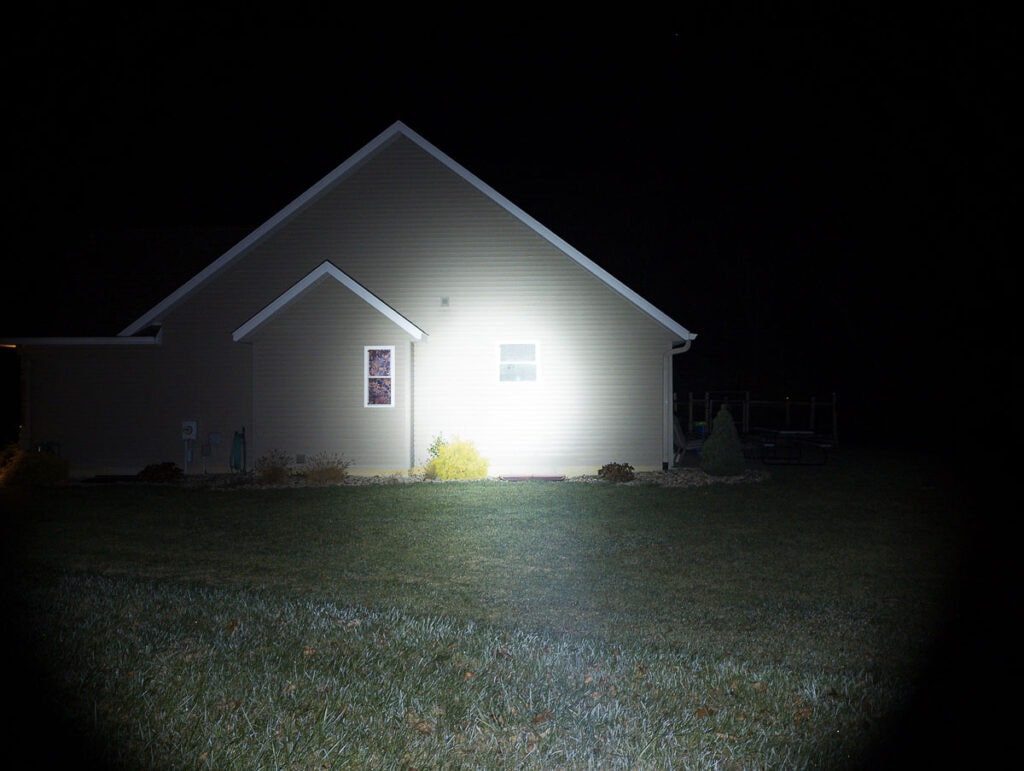
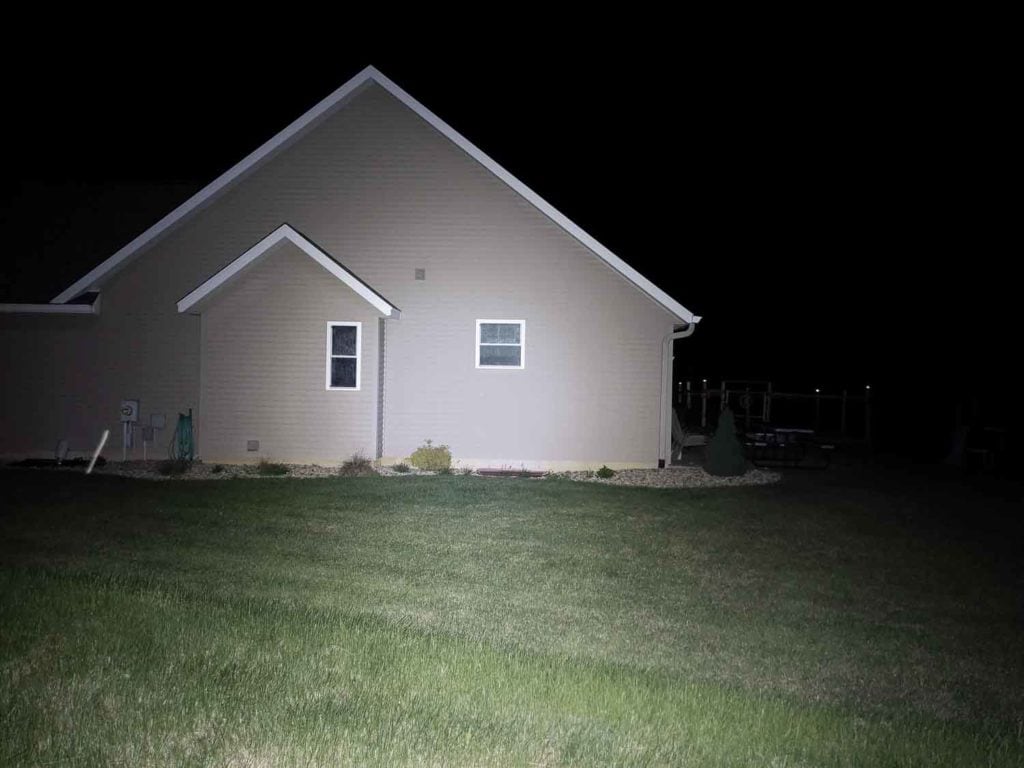
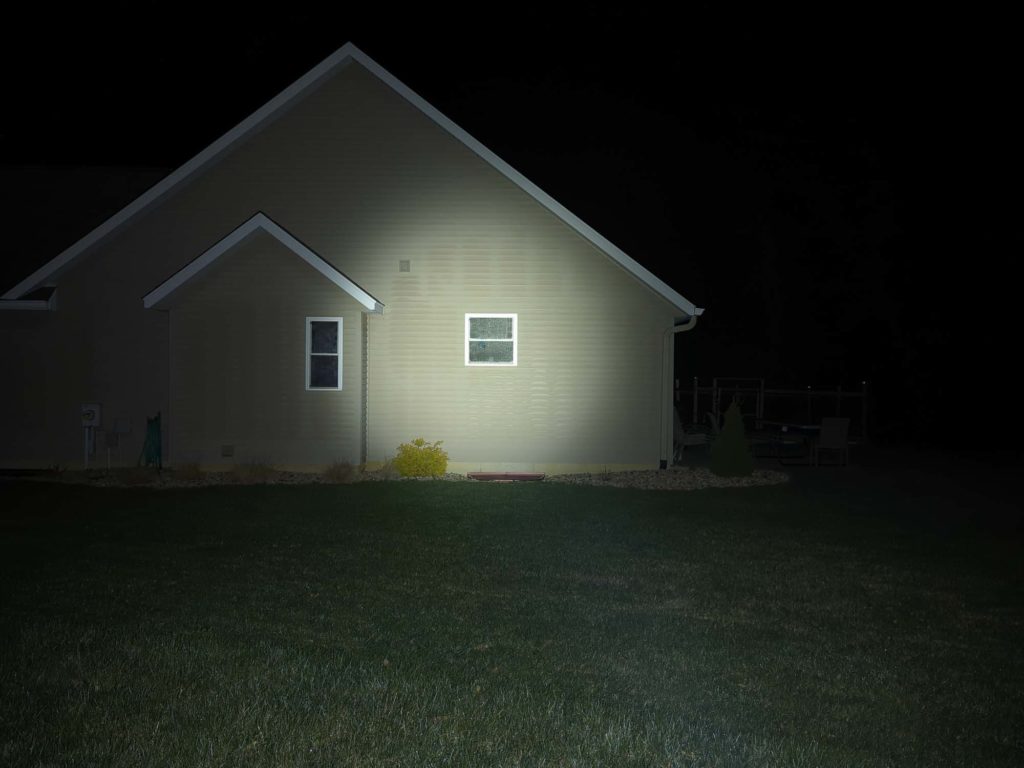
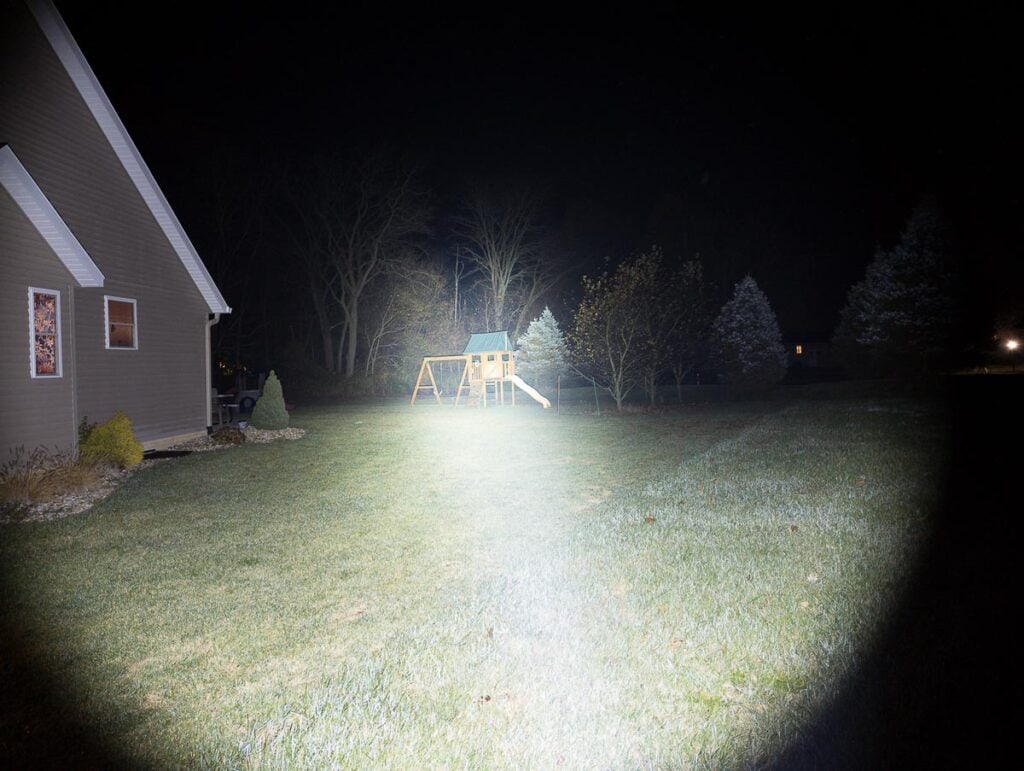

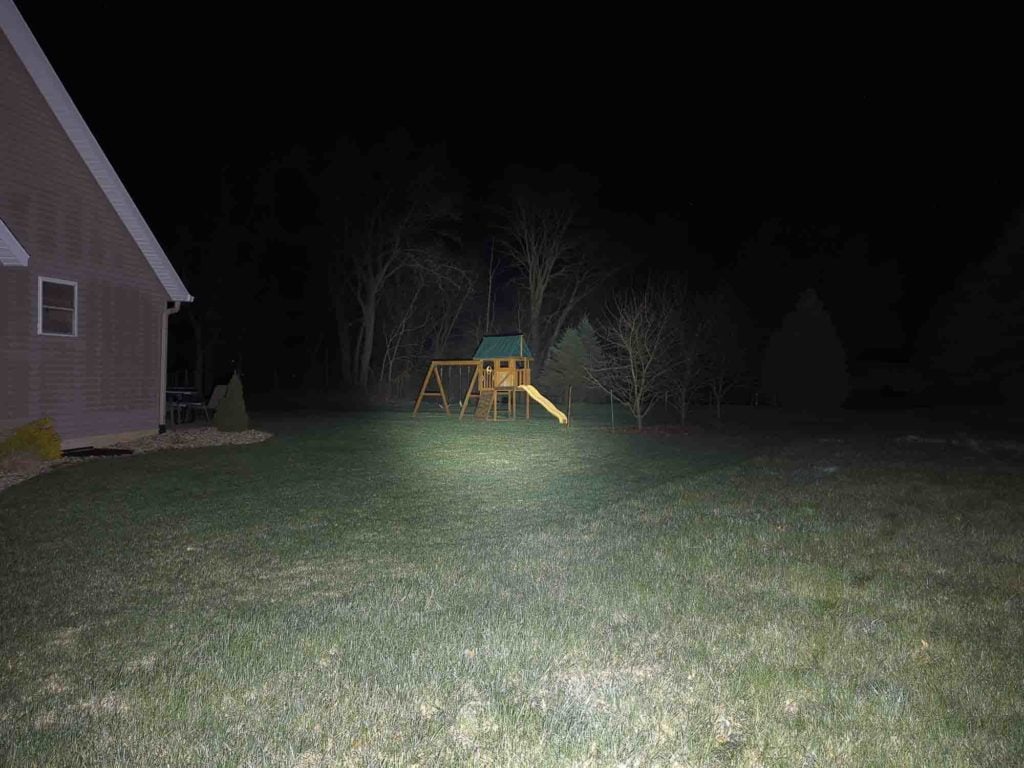
Disclaimer: This flashlight was sent to me for review at no cost by Fenix Lighting. I have not been paid to review, nor have I been holding back on problems or defects.
Final Verdict
Pros
- Great build quality
- Excellent regulation
- USB-C charging
- Easy dual-switch UI
Cons
- No shortcuts for Eco or Turbo modes
Explanation on star ratings:
1: Avoid: a match would be a better choice – 2: Poor: significant defect or issues; almost unusable – 3: Average: some defects or issues; but still usable 4: Good: recommended (minor issues) – 5: Great: highly recommended

5 stars: ★★★★★
If I’m being perfectly honest with myself, most of my flashlights that I have out and available are more for show than anything. Either they were fun to build, or they have fancy aux lighting, or they have just the right CCT and tint. Those are nice and all, but I put them in a completely different category than what you see with the Fenix PD36R Pro.
It isn’t designed to be fun or flashy; it’s a work tool through and through. From the great build quality and warranty, to the included holster, the simple user interface, and the high-output and no-nonsense SFT70 LED, it’s clear to see that Fenix made the PD36R Pro to be a workhorse. And I’d say they nailed that objective.
Buy Fenix PD36R PRO with 10% discount
Get 10% off every purchase at Fenix Lighting US, by using our exclusive 1lumen discount code: 1lumen10
1lumen selects and reviews products personally. We may earn affiliate commissions through our links, which help support our testing.